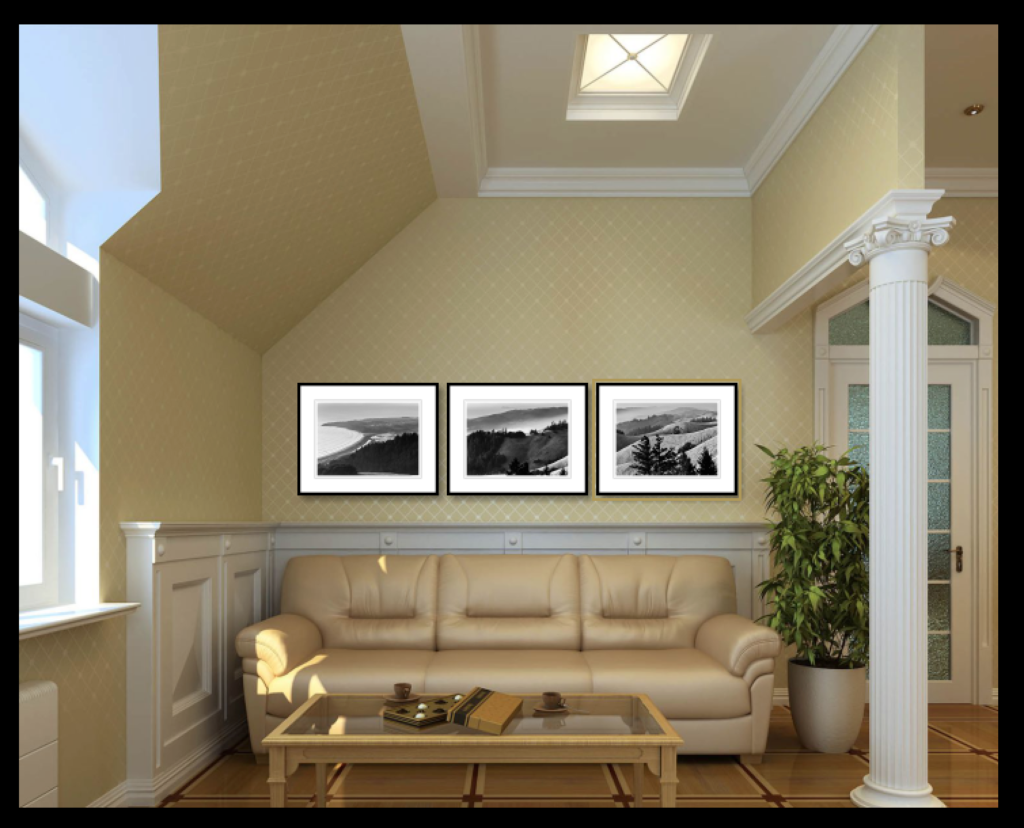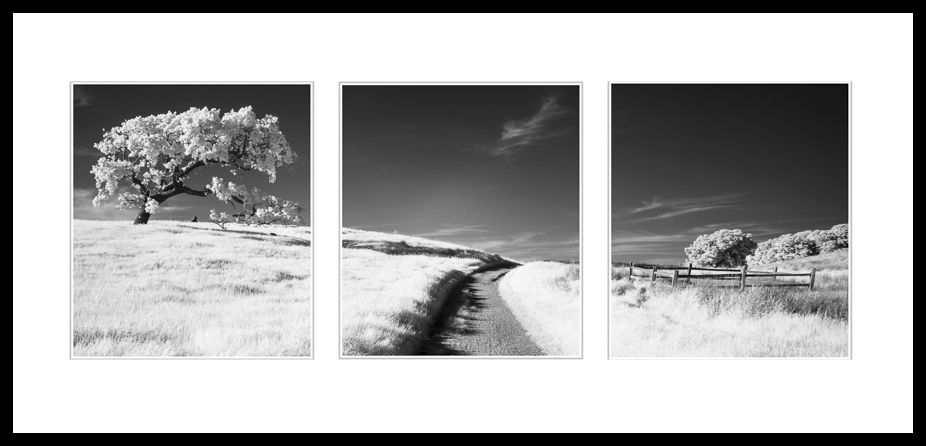According to Wikipedia, the triptych is a sacred form that originated in early Christian art where it appeared as altar pieces. The art was presented in three panels and was usually hinged together. The three pieces created a much wider, dramatic presentation. This panoramic artwork provided the viewer with virtual windows opening into a larger world.
I’ve been making triptychs for more than 25 years. My very first attempts, like the early church artisans, were hinged versions. But, they were heavy, unwieldily and nearly impossible to hang safely. I abandoned the hinged version but continued to make individually-framed versions. Once I acquired a larger mat cutter I began producing single-piece triptychs featuring large mats with triple windows to reveal the three photographs. This is the method I use most frequently today. Some collectors prefer individually-framed versions and so I continue to offer that style too. Samples of these varying styles of triptych framing are here: Art on Walls.

Bolinas Rdg. 3 Traditionally framed
Single Scene Triptychs – Two Origins
Additive Triptychs
All my first triptychs were made from a single scene, painstakingly photographed on film – each panel a separate exposure. I searched for landscapes that would be dynamic in it’s entirety, but would have features that would be suitable that each exposure (panel) would be interesting to the eye. Each exposure is added to the others to complete the continuous scene. The best ones I made are the Bolinas Ridge Triptych and the Point Reyes Triptych. I didn’t have a name for this kind of triptych, but I now call them “single-scene additive triptychs.”
Divided Triptychs
A few years ago a client needed a very large artwork for her New York home. Logistics and framing required a new approach. My more panoramic triptychs would not work in the space. I searched my catalog for a high-quality film image that could be divided into three vertical panels, framed individually and hung in series. Tomales Bay and Black Mountain, a sweeping view of the Point Reyes area was repurposed to become the Olema Hill Triptych. The photograph divided beautifully into three interesting panels. This is my first “single-scene divided triptych.” I have since found two other large-format film photographs that also divide beautifully: the Tamalpais Ridges and Alabama Hills triptychs have been added to my online collection.
Multiple-Scene Triptychs
Other evocative triptychs can be created by the careful combining of related, harmonious photographs. Shapes, places, subject matter, even weather can create the grouping. For instance, these botanicals were found at the same place enjoying the same refreshing morning dew. This North Bay Trees Triptych includes three majestic trees captured in the infrared spectrum during the spring of 2015. Triptychs can be linked together by shape: Parabolic Dunes. These portraits of teasels, seem to be animated, connected by their gestures: Teasel Dancers. A lake, the ocean, and the desert share the beauty of a darkened sky in California Dark Skies.
I’ve been making triptychs for over 25 years now. The triptychs I create today honor the ancient art form. I’ve just added a dozen new triptychs to my Triptych Collection here. The most popular sizes can be ordered online, but if you need something bigger please contact me. Triptych art will open windows to a larger world on your wall!
Here are samples, of actual and virtual triptych installations. My free Art preview service enables you to visualize artwork on your own walls to assess size and compositions.




Great stuff, Marty! Love all the variations you’ve done on the basic triptych concept.
Follow-up… Hadn’t clicked on your Collection link yet, when I posted the previous comment….
You DID do some Night Sky Triptychs!! The Joshua Tree one is Spectacular! Going to have to have a chat about getting one of those from you in the next couple of months…. (a BIG one too….) 🙂 🙂
Stuart- I’m pleased that you like my new Joshua Tree, Night Sky triptychs. I have been wanting to do this for a long time and have finally spent the time to find photographs that work well together in the triptych format. I’m looking forward to making the first editions, so let me know when you’d like to look over some proofs and think about scale. In the meantime I send you best wishes and good luck for the summer! -Marty
I was hoping you would do one your Night Sky Star Field subjects in a Triptych format (if you have not already done so?).
It’s such an amazing format for large scale panoramas, that I think that would look truly amazing.
To me a Triptych is where a Photographer really gets to show-off their stuff, due to the thought required in the image pairing and even the mounting and framing process.
Another Awesome Post Mr. Knapp…. 🙂
Marty – I continue to learn something new from each of your posts. The “triptychs” mounting/framing format is very interesting display that further enhances the photographic story or scene. I had not given much thought to the origin or name for that matter and always referred to this display format as “panels”. Now I know, and big thank you for my continuing education.
My pleasure, Terry! A friend turned me onto making triptychs some 25 years ago. I love making them for all the reasons I stated in this recent blog. Take care, my friend.